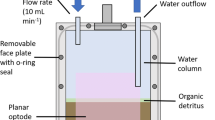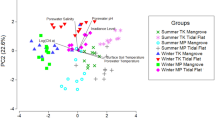Abstract
Bacterial productivity (3H-thymidine incorporation into DNA) and intertidal microbenthic communities were examined within five mangrove estuaries along the tropical northeastern coast of Australia. Bacteria in mangrove surface sediments (0–2 cm depth) were enumerated by epifluorescence microscopy and were more abundant (mean and range: 1.1(0.02–3.6)×1011 cells·g DW−1) and productive (mean: 1.6 gC·m−2· d−1) compared to bacterial populations in most other benthic environments. Specific growth rates (¯x=1.1) ranged from 0.2–5.5 d−1, with highest rates of growth in austral spring and summer. Highest bacterial numbers occurred in winter (June–August) in estuaries along the Cape York peninsula north of Hinchinbrook Island and were significantly different among intertidal zones and estuaries. Protozoa (105−106·m−2, pheopigments (0.0–24.1μg·gDW−1) and bacterial productivity (0.2–5.1 gC·m−2·d−1) exhibited significant seasonality with maximum densities and production in austral spring and summer. Algal biomass (chlorophylla) was low (mean: 1.6μg·gDW−1) compared to other intertidal sediments because of low light intensity under the dense forest canopy, especially in the mid-intertidal zone. Partial correlation analysis and a study of possible tidal effects suggest that microbial biomass and bacterial growth in tropical intertidal sediments are regulated primarily by physicochemical factors and by tidal flushing and exposure. High microbial biomass and very high rates of bacterial productivity coupled with low densities of meiofaunal and macroinfaunal consumers observed in earlier studies suggest that microbes may be a sink for carbon in intertidal sediments of tropical mangrove estuaries.
Similar content being viewed by others
References
Alongi DM (1985) Effect of physical disturbance on population dynamics and trophic interactions among microbes and meiofauna. J Mar Res 43:351–364
Alongi DM (1986) Quantitative estimates of benthic protozoa in tropical marine systems using silica gel: a comparison of methods. Est Coastal Shelf Sci 23:443–450
Alongi DM (1987) Intertidal zonation and seasonality of meiobenthos in tropical mangrove estuaries. Mar Biol 95:447–458
Alongi DM, Hanson RB (1985) Effect of detritus supply on trophic relationships within experimental benthic food webs. II. Microbial responses, fate and composition of decomposing detritus. J Exp Mar Biol Ecol 88:167–182
Benner R, Hodson RE (1985) Microbial degradation of the leachable and lignocellulose components of leaves and wood fromRhizophora mangle in a tropical mangrove swamp. Mar Ecol Prog Ser 23:221–230
Boto KG, Wellington JT (1984) Soil characteristics and nutrient status in northern Australian mangrove forests. Estuaries 7:61–69
Boto KG, Bunt JS, Wellington JT (1984) Variations in mangrove forest productivity in Northern Australia and Papua New Guinea. Est Coastal Shelf Sci 19:321–329.
Branch GM, Branch ML (1980) Competition inBembicuim auratum (Gastropoda) and its effect on microalgal standing stock in mangrove muds. Oecologia 46:106–114
Bratbak LR (1985) Bacterial biovolume and biomass estimations. Appl Environ Microbiol 49:1488–1493
Bunt JS (1982) Studies of mangrove litter fall in tropical Australia. In: Clough BF (ed) Mangrove ecosystems in Australia. Australian National University Canberra, pp 223–237
Cundell AM, Brown MS, Stanford R, Mitchell R (1979) Microbial degradation ofRhizophora mangle leaves immersed in the sea. Est Coastal Mar Sci 9:281–286
Ducklow HW (1983) The production and fate of bacteria in the oceans. Bioscience 33:494–501
Ducklow HW, Purdie DA, Williams PJ LeB, Davies JM (1986) Bacterioplankton: a sink for carbon in a coastal marine plankton community. Science 232:865–867
Ellery WH, Schleyer MH (1984) Comparison of homogenization and ultrasonification as techniques in extracting attached sedimentary bacteria. Mar Ecol Prog Ser 15:247–250
Fallon RD, Newell SY, Hopkinson CS (1983) Bacterial production in marine sediments: will cell-specific measures agree with whole-system metabolism? Mar Ecol Prog Ser 11:119–127
Fell JW, Cefalu RC, Master IM, Tallman AS (1975) Microbial activities in the mangrove (Rhizophora mangle) leaf detrital system. In: Walsh G, Snedaker S, Teas H (eds) Proc Int Symp Biol Managmt Mangroves. University of Florida, Gainesville, pp 661–679
Fenchel T (1968) The ecology of marine microbenthos. I. The food for marine benthic ciliates. Ophelia 5:73–121
Fenchel T (1986) The ecology of heterotrophic microflagellates. Adv Microb Ecol 9:57–97
Fenchel T, Blackburn TH (1979) Bacteria and mineral cycling. Academic Press, New York
Ferguson RL, Murdoch MB (1975) Microbial ATP and organic carbon in the sediments of the Newport River Estuary, North Carolina. In: Cronin LE (ed) Estuarine research. Academic Press, New York, pp 229–250
Findlay RH, Pollard PC, Moriarty DJW, White DC (1985) Quantitative determination of microbial activity and community nutritional status in estuarine sediments: evidence for a disturbance artifact. Can J Microbiol 31:493–498
Folk RL (1974) Petrology of sedimentary rocks. Hemphill, Austin, Texas
Fuhrman JA, Azam F (1982) Thymidine incorporation as a measure of heterotrophic bacterioplankton production in marine surface waters: evaluation and field results. Mar Biol 66: 109–120
Gillian FT, Hogg R (1984) A method for the estimation of bacterial biomass and community structure in mangrove-associated sediments. J Microbiol Meth 2:275–293
Hedgepeth JW (1957) Classification of marine environments. In: Hedgepeth JW (ed) Treatise on marine ecology and paleoecology, vol. 1. Ecology Geol Soc Amer, Washington, D.C., pp 17–28
Hobbie JE, Daley RJ, Jasper S (1977) Use of Nuclepore filters for counting bacteria by fluorescence microscopy. Appl Environ Microbiol 33:1225–1228
Howarth RW, Hobbie JE (1982) The regulation of decomposition and heterotrophic activity in salt marsh soils: a review. In: Kennedy VS (ed) Estuarine comparisons. Academic Press, New York, pp 183–207
Kirchman D, Peterson B, Juers D (1984) Bacterial growth and tidal variation in bacterial abundance in the Great Sipperwissett salt marsh. Mar Ecol Prog Ser 19:247–259
Legendre L, Legendre P (1983) Numerical ecology. Elsevier Scientific Publications, Amsterdam
Lorenzen CJ (1967) Determination of chlorophyll and phaeopigments: spectrometric equations. Limnol Oceanogr 12:343–346
Macnae W (1968) A general account of the fauna and flora of mangrove swamps and forests in the Indo-West-Pacific region. Adv Mar Biol 6:73–270
Meyer-Reil LA (1984) Bacterial biomass and heterotrophic activity in sediments and overlying waters. In: Hobbie JE, Williams PJ LeB (eds) Heterotrophic activity in the sea. Plenum Press, New York, pp 523–546
Montagna PA (1982) Sampling design and enumeration statistics for bacteria extracted from marine sediments. Appl Environ Microbiol 43:1366–1372
Moriarty DJW (1986) Measurement of bacterial growth rates in aquatic systems from rates of nucleic acid synthesis. Adv Microb Ecol 9:245–292
Moriarty DJW, Pollard PC (1981) DNA synthesis as a measure of bacterial productivity in seagrass sediments. Mar Ecol Prog Ser 5:151–156.
Moriarty DJW, White DC, Wassenberg TJ (1985) A convenient method for measuring rates of phospholipid synthesis in seawater and sediments: its relevance to the determination of bacterial productivity and the disturbance artifacts introduced by measurements. J Microbiol Meth 3:321–330
Moriarty DJW, Pollard PC, Alongi DM, Wilkinson CR, Gray JS (1985) Bacterial productivity and trophic relationships with consumers on a coral reef. Proc 5th Intl Coral Reef Congr 5:457–462
Newell RC (1984) The biological role of detritus in the marine environment. In: Fasham MJR (ed) Flows of energy and materials in marine ecosystems. Plenum Press, New York, pp 317–343
Newell SY, Fallon RD (1982) Bacterial productivity in the water column and sediments of the Georgia (USA) coastal zone: estimates via direct counting and parallel measurement of thymidine incorporation. Microb Ecol 8:33–46
Novitsky JA, Karl DM (1986) Characterization of microbial activity in the surface layers of a coastal subtropical sediment. Mar Ecol Prog Ser 28:49–55
Payne WJ, Wiebe WJ (1978) Growth yield and efficiency in chemosynthetic organisms. Ann Rev Microbiol 32:155–183
Pollard PC, Moriarty DJW (1984) Validity of the tritiated thymidine method for estimating bacterial growth rates: measurement of isotope dilution during DNA synthesis. Appl Environ Microbiol 48:1076–1083j
Pomeroy LR (1984) Significance of microorganisms in carbon and energy flow in marine ecosystems. In: Klug MJ, Reddy CA (eds) Current perspectives in microbial ecology. Amer Soc Microbiol, Washington DC, pp 405–411
Pomeroy LR, Wiegert RG (eds) (1981) The ecology of a salt marsh. Springer-Verlag, Berlin
Robertson AI (1987) The determination of trophic relationships in mangrove-dominated systems: areas of darkness. In: Field CD (ed) Mangrove ecosystems of Asia and the Pacific: status, exploitation and management. AIMS and Australian Committee for Mangrove Research, Townsville, Australia, pp 292–304
Rublee PA (1982) Bacteria and microbial distribution in estuarine sediments. In: Kennedy VS (ed) Estuarine comparisons. Academic Press, New York, pp 159–182
Rublee PA, Merkel SM, Faust MA (1983) The transport of bacteria in the sediments of a temperate marsh. Est Coastal Shelf Sci 16:501–509
Sherr BF, Sherr EB, Berman T (1983) Grazing, growth and ammonium excretion rates of a heterotrophic microflagellate fed with four species of bacteria. Appl Environ Microbiol 45: 1196–1201
Sokal RR, Rohlf RJ (1969) Biometry. WH Freeman and Co, San Francisco
Staley JT, Konopka A (1985) Measurement of in situ activities of nonphotosynthetic micro-organisms in aquatic and terrestrial habitats. Ann Rev Microbiol 39:321–346
Wells FE (1983) An analysis of marine invertebrate distributions in a mangrove swamp in Northwestern Australia. Bull Mar Sci 33:736–744
Williams PJ LeB (1983) Bacterial production in the marine food chain: the emperor's new suit of clothes? In: Fasham MJR (ed) Flows of energy and materials in marine ecosystems. Plenum Press, New York
Wood LW (1985) Chloroform-methanol extraction of chlorophylla. Can J Fish Aquat Sci 42:38–43
Author information
Authors and Affiliations
Rights and permissions
About this article
Cite this article
Alongi, D.M. Bacterial productivity and microbial biomass in tropical mangrove sediments. Microb Ecol 15, 59–79 (1988). https://doi.org/10.1007/BF02012952
Issue Date:
DOI: https://doi.org/10.1007/BF02012952




